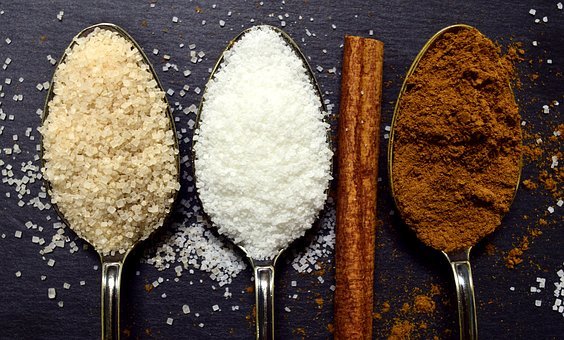Let’s get one thing clear my friends. Artificial sweeteners are chemicals. They are not the same thing as plant based, zero calorie sweeteners. There are many of both kinds of sugar substitutes out there. Here is a quick overview of the more popular ones:
SACCHARIN is an artificial sweetener with a sulfa base. It has a slight metallic aftertaste. Saccharin may cause nausea, diarrhea, skin problems, or other common allergic symptoms. It has even been linked to bladder cancer. My body reacts to saccharin as if I have had soda. I use the restroom repeatedly every hour. It makes me more thirsty afterwards, and then I tend to crave salty things.
ASPARTAME is made from Phenylalanine, aspartic acid, and methanol gas. It also has a slightly bitter or metallic aftertaste. Side effects may include headaches, memory loss, anxiety, heart palpitations, and weight gain! What? Weight gain? Yes, the body thinks it is enjoying sugar, and may spike the insulin as if you had sugar anyway.
SUCRALOSE is a substance made by chlorinating sugar. The chemical structure of the type of chlorine in the table top sucralose is the type of chlorine that is banned in the pesticide named DDT! People who use sucralose have reported headaches, muscle aches, cramps, diarrhea, dizziness, and inflammation. Sucralose can impact the immune system, the liver, and the kidneys.
STEVIA is a plant based zero calorie sweetener. It grows in South America and Central America. The leaves are dried and powdered. Some brands do have a metallic or bitter aftertaste. Some people report that after a while they do not notice it. Low doses of stevia have been used for years in Japan for lowering high LDL cholesterol (the bad kind) and controlling type 2 diabetes.
LUO HAN GUO is the extract from the Chinese monk fruit. It has been used for centuries in Asia as a sweet tea for sore throats, flu, and joint pain. The Japanese have crystallized it into a brown, sugar-like substance called Lakanto. It is zero calorie, and has no effect on the glycemic index. It has no bitter or metallic aftertaste. Some American companies are using the sugar substitute in their health food products now. Some newer versions of the sugar substitute have added corn starch to the ingredients list. As always, I suggest reading labels. Lakanto released a white sugar version recently, but for me, the golden brown version is more authentic to the sugar taste.
XYLITOL is a low calorie sweetener extracted from the bark of the birch tree. Some companies extract other hard wood barks and plants as well. It looks, tastes, and bakes like white sugar. It does have calories, about 9-10 per teaspoon, but will not spike the insulin levels in the body, as it is very low on the glycemic index. There is no aftertaste at all. Over consumption of xylitol can cause gas, diarrhea, and bloating in some cases.
Artificial sweeteners can stimulate the appetite and cravings, therefore making us eat more than we may need. It creates in our body the supposition that we took in more calories than we actually did (from sugar), so after a while when the digestion system gets the message from the brain that we didn’t actually eat a lot of calories, we physically need to fill that void. Artificial chemical sweeteners disrupt the insulin and leptin receptors. Our metabolism gets confused. Some artificial sweeteners have chemicals in them that stimulate and excite the brain cells so much, that they are called excitotoxins. First they excite the brain cells, then they kill them off.
Personally, I use Lakanto golden brown variety and Xyla white for my sugar alternatives. Now I am experimenting with coffee and tea without any sweetener, just cinnamon sprinkled in or lemon. I have had no side effects from either plant based sweetener.
I hope this helps clear up any confusion on sweeteners.
Blessings,
KJ Landis


 RSS Feed
RSS Feed